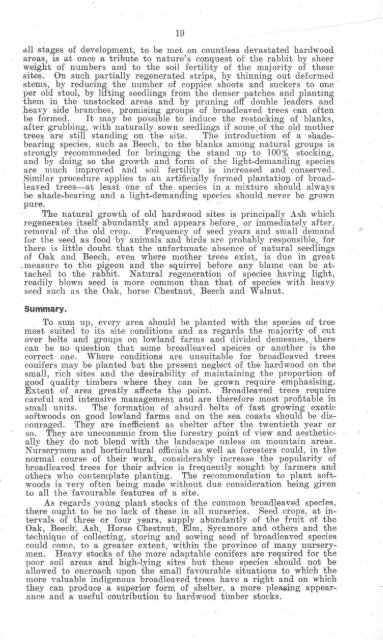Download Full PDF - 19.3 MB - The Society of Irish Foresters
Download Full PDF - 19.3 MB - The Society of Irish Foresters
Download Full PDF - 19.3 MB - The Society of Irish Foresters
Create successful ePaper yourself
Turn your PDF publications into a flip-book with our unique Google optimized e-Paper software.
19<br />
d.ll stages <strong>of</strong> development, to be met on countless devastated hardwood<br />
areas, is at once a tribute to nature's conquest <strong>of</strong> the rabbit by sheer<br />
weight <strong>of</strong> numbers and to the soil fertility <strong>of</strong> the majority <strong>of</strong> these<br />
sites. On such ;partially regenerated strips, by thinning out deformed<br />
stems, by reduclllg the number <strong>of</strong> coppice shoots and suckers to one<br />
per old stool, by lifting seedlings from the denser patches and planting<br />
them in the un stocked areas and by pruning <strong>of</strong>f double leaders and<br />
heavy side branches, promising groups <strong>of</strong> broadleaved trees can <strong>of</strong>ten<br />
be formed. It may be possible to induce the restocking <strong>of</strong> blanks,<br />
after grubbing, with naturally sown seedlings if some <strong>of</strong> the old mother<br />
trees are still standing on the site. <strong>The</strong> introduction <strong>of</strong> a shadebearing<br />
species, such as Beech, to the blanks among natural groups is<br />
strongly recommneded for bringing the stand up to 100% stocking,<br />
and by doing so the growth and form <strong>of</strong> the light-demanding species<br />
are much improved and soil fertility is increased and conserved.<br />
Similar procedure applies to an artificially formed plantatio!} <strong>of</strong> broadleaved<br />
trees-at least one <strong>of</strong> the species in a mixture should always<br />
be shade.bearing and a light-demanding species should never be grown<br />
pure.<br />
·<strong>The</strong> natural growth <strong>of</strong> old hardwood sites is principally Ash which<br />
regelierates itself abundantly and appears before, or immediately after,<br />
removal <strong>of</strong> the old crop. Frequency <strong>of</strong> seed years and small demand<br />
for the seed as food by animals and birds are probably responsible, for<br />
there is little doubt that the unfortunate absence <strong>of</strong> natural seedlings<br />
<strong>of</strong> Oak and Beech, even where mother trees exist, is due in great<br />
.measure to the pigeon and the squirrel before any blame can be attached<br />
to the rabbit. Natural regeneration <strong>of</strong> species having light,<br />
readily blown seed is more common than that <strong>of</strong> species with heavy<br />
seed such as the Oak, horse Chestnut, Beech and Walnut.<br />
Summary.<br />
To sum up, every area should be planted with the species <strong>of</strong> tree<br />
most suited to its site conditions and as regards the majority <strong>of</strong> cut<br />
over belts and g.roups on lowland farms and divided demesnes, there<br />
can be no question that some broadleaved speices or another is the<br />
correct one. Where conditions are unsuitable for broadleaved trees<br />
conifers may be planted but the present neglect <strong>of</strong> the hardwood on the<br />
small, rich sites and the desirability <strong>of</strong> maintaining the proportion <strong>of</strong><br />
good quality timbers where they can be grown require emphasising.<br />
Extent <strong>of</strong> area greatly affects the point. Broadleaved trees require<br />
careful and intensive management and are therefore most pr<strong>of</strong>itable in<br />
small units. <strong>The</strong> formation <strong>of</strong> absurd belts <strong>of</strong> fast growing exotic<br />
s<strong>of</strong>twoods on good lowland farms and on the sea coasts should be discOUl·aged.<br />
.<strong>The</strong>y are inefficient as shelter after the twentieth year or<br />
so. <strong>The</strong>y are uneconomic from the forestry point <strong>of</strong> view and aesthetically<br />
they do not blend with the landscape unless on mountain areas.<br />
Nurserymen and horticultural <strong>of</strong>ficials as well as foresters could, in the<br />
normal course <strong>of</strong> their work considerably increase the popularity <strong>of</strong><br />
broadleaved trees for their advice is frequently sought by farmers and<br />
others who contemplate planting. <strong>The</strong> recommendation to plant s<strong>of</strong>twoods<br />
is very <strong>of</strong>ten being made without due consideration being given<br />
to all the favourable features <strong>of</strong> a site.<br />
As regards young plant stocks <strong>of</strong> the common broadleaved species,<br />
there ought to be no lack <strong>of</strong> these in all nurseries. Seed crops, at intervals<br />
<strong>of</strong> three or four years, supply abundantly <strong>of</strong> the fruit <strong>of</strong> the<br />
Oak, Beech, Ash, Horse Chestnut. Elm, Sycamore and others and the<br />
technique <strong>of</strong> collecting, storing and sowing seed <strong>of</strong> broadleaved species<br />
could come, to a greater extent, within the province <strong>of</strong> many nurserymen.<br />
Heavy stocks <strong>of</strong> the more adaptable conifers are required for the<br />
poor soil areas and high-lying sites but these species should not be<br />
allowed to encroach upon the small favour.ablesituations to which the<br />
more valuable indigenous broadleaved trees have a right and on which<br />
they can produce a superior form <strong>of</strong> shelter, a more pleasing appearance<br />
and a useful contribution to hardwood timber stocks.<br />
..

















